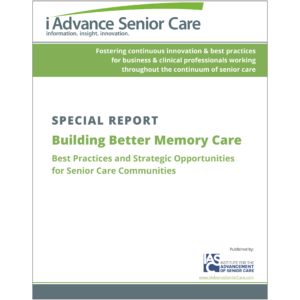Memory boxes? Forget about them
Long-term care communities are moving away from using memory boxes as cuing tools for residents, according to speakers at the Environments for Aging Conference.
“It’s an awful lot of money to invest, and a lot of my clients don’t have that money anymore,” said Julie Bessant Pelech, BES, C. Gerontology. Pelech, of Bessant Pelech Associates, facilitated a workshop titled "Juggling Act: Design Solutions for Person-Centered Care" with Jane Rohde, AIA, FIIDA, ACHA, AAHID, principal of JSR Associates; Sandra Harris, principal of S Harris Interiors; and Elizabeth "Betsy" Brawley, AAHID, IIDA, CID, a healthcare interior designer with Design Concepts Unlimited.
The issues with the boxes—often built into walls at the entrances to resident rooms to indicate to residents that they have reached their personal spaces—go beyond cost, however, Pelech added.
“I can tell you of all the buildings I’ve worked on, where the vast majority do have those memory boxes, when you go back [to visit], they actually kind of underscore who has a caring family and who does not. So it can be really very depressing,” she said. “And if they’re not used, then why are they there?”
Some families are active in residents’ lives, Pelech said, but they do not realize that it is their responsibility to fill the boxes with mementos. “If they’re not used appropriately, with real cuing tools for the resident, then they are useless as a landmark or a cue,” she added. Communities with buildings that incorporate memory boxes into their designs should improve education of staff and family members so that the boxes are filled with appropriate items, Rohde said.
Research on the effectiveness of the memory box as a cuing tool is limited, the speakers noted.
“For 20 years, this has been a standard practice…and I can tell you that we’re actually migrating away from the memory box as long as we have some other things at the door,” such as a permanent frame, Pelech said. A family photo “might be more effective than spending a whole lot of money on a memory box that we’re not 100 percent sure that your staff are going to help families know that that’s their responsibility to bring that memory box alive,” she added.
Harris suggested alternatives such as individualized mailboxes or doorknockers.
For more coverage of this workshop, click here.
I Advance Senior Care is the industry-leading source for practical, in-depth, business-building, and resident care information for owners, executives, administrators, and directors of nursing at assisted living communities, skilled nursing facilities, post-acute facilities, and continuing care retirement communities. The I Advance Senior Care editorial team and industry experts provide market analysis, strategic direction, policy commentary, clinical best-practices, business management, and technology breakthroughs.
I Advance Senior Care is part of the Institute for the Advancement of Senior Care and published by Plain-English Health Care.
Related Articles
Topics: Articles , Design , Executive Leadership , Operations











